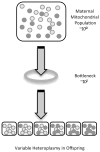Mitochondrial DNA, nuclear context, and the risk for carcinogenesis
- PMID: 29332303
- PMCID: PMC6045969
- DOI: 10.1002/em.22169
Mitochondrial DNA, nuclear context, and the risk for carcinogenesis
Abstract
The inheritance of mitochondrial DNA (mtDNA) from mother to child is complicated by differences in the stability of the mitochondrial genome. Although the germ line mtDNA is protected through the minimization of replication between generations, sequence variation can occur either through mutation or due to changes in the ratio between distinct genomes that are present in the mother (known as heteroplasmy). Thus, the unpredictability in transgenerational inheritance of mtDNA may cause the emergence of pathogenic mitochondrial and cellular phenotypes in offspring. Studies of the role of mitochondrial metabolism in cancer have a long and rich history, but recent evidence strongly suggests that changes in mitochondrial genotype and phenotype play a significant role in the initiation, progression and treatment of cancer. At the intersection of these two fields lies the potential for emerging mtDNA mutations to drive carcinogenesis in the offspring. In this review, we suggest that this facet of transgenerational carcinogenesis remains underexplored and is a potentially important contributor to cancer. Environ. Mol. Mutagen. 60:455-462, 2019. © 2018 Wiley Periodicals, Inc.
Keywords: cancer; heteroplasmy; mitochondrion; mutagenesis; transplacental.
© 2018 Wiley Periodicals, Inc.
Figures


Comment in
-
Reply.Environ Mol Mutagen. 2019 Jun;60(5):465. doi: 10.1002/em.22181. Epub 2018 Mar 14. Environ Mol Mutagen. 2019. PMID: 29536566 No abstract available.
-
Single nucleotide mtDNA polymorphisms may contribute to cancerogenesis in mitochondrial disorders.Environ Mol Mutagen. 2019 Jun;60(5):463-464. doi: 10.1002/em.22180. Epub 2018 Mar 14. Environ Mol Mutagen. 2019. PMID: 29536588 No abstract available.
References
Publication types
MeSH terms
Substances
Grants and funding
LinkOut - more resources
Full Text Sources
Other Literature Sources

